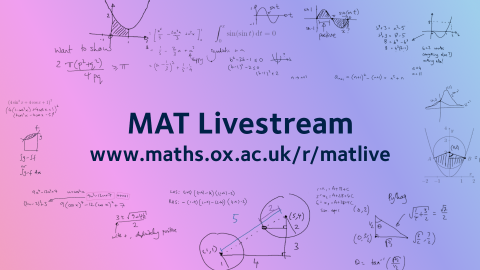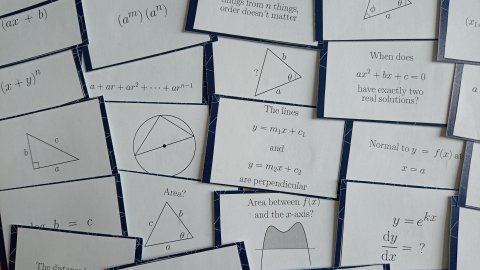Maths Admissions Test
About the test
Why is there a test?
We can't interview all our applicants in the time available, so we shortlist around three applicants for every place to interview. To help us decide who to shortlist, we set the Mathematics Admissions Test (MAT) which all applicants for Maths, Computer Science, or joint honours courses must take. There is no "pass" mark for the MAT; we use the information from the test, together with all the details of your UCAS application and information about school background to decide who to shortlist.
What does the MAT test?
The MAT aims to test the depth of mathematical understanding of a student in the fourth term of their A-levels (or equivalent) rather than a breadth of knowledge. It is set with the aim of being approachable by all students, including those without Further Mathematics A-level, and those from other educational systems (e.g. Baccalaureate and Scottish Highers).
The MAT syllabus is based on the first year of A level Maths, and a few topics from the fourth term of A level Maths which we think students will have covered by the time of the test.
Test Format
Like all Oxford admissions tests in 2025, the MAT will be online, delivered in partnership with Pearson VUE via its established network of test centres. For registration, please see www.ox.ac.uk/tests.
The test lasts 2½ hours. Candidates who receive extra time in other examinations should receive extra time in the MAT.
The format for the test in 2025 is the same as it was in 2024, and very similar to previous years. The MAT consists of 27 questions, and all candidates should attempt all questions. Of these, 25 questions are multiple-choice. Each multiple-choice question is worth 2 or 3 or 4 marks, with the number of marks for each question given alongside each question.
There are two longer questions, for which candidates will type responses. Candidates are not expected to type complex mathematical expressions or use any symbols beyond those included on a standard keyboard (alphanumeric characters, + - =, and similar). As with long MAT questions from previous years, candidates should expect to justify their answers or explain their reasoning for these long questions. Each of the long questions is worth 15 marks. The responses for these questions are marked by a team based in Oxford, and partial solutions are awarded partial credit.
In total, the test is marked out of 100.
There is a practice test to demonstrate what the Pearson VUE system looks like, with a link below. The questions for this practice test are past MAT questions from 2007-2022. For more past MAT questions and worked solutions, scroll down to the table of past papers below.
How to prepare for the MAT
The MAT syllabus contains the mathematics that we expect you to know by the time of the test.
For practice resources, see the Oxford MAT Livestream.
You might also like the following resources to practice problem-solving;
Key dates
18 June to 19 September 2025: Candidates register for the MAT via www.ox.ac.uk/tests. Deadline is 6pm BST on 19 September 2025.
18 August to 26 September 2025: Registered candidates book a slot to take the test. Deadline is 6pm BST on 26 September 2025.
22 October and 23 October 2025: Test dates for the MAT
November 2025: Oxford marks the MAT and makes shortlisting decisions.
January 2026: MAT scores are sent to candidates via the test registration platform.
MAT past papers
The table below contains past papers and solutions, as well as general feedback on the admissions round for each year from 2010 onwards. Three averages are given for each year; $\mu_1$ is the average score of all Oxford applicants for Maths / Maths & Stats / Maths & Philosophy, $\mu_2$ is the average score of those applicants who were shortlisted for interview, and $\mu_3$ is the average score of those applicants who were made offers. Similar statistics for Maths & Computer Science, Computer Science, and Computer Science & Philosophy applicants are available on the Computer Science departmental website.
Please note that the syllabus for the MAT was updated for the 2018 test; the current syllabus is available here.
The Notes for the past papers are intended for candidates using the past papers to prepare for MAT, and they mostly refer to syllabus changes.
Additional Multiple-Choice Questions
In 2020, 2021, and 2022, the department organised a multiple-choice test in the style of the MAT. This was arranged for a small number of candidates in each year who had been shortlisted without a MAT score, and the test was administered just before interviews. In 2023, the department organised a multiple-choice test for candidates affected by technical disruption in the MAT, and the test was administered before shortlisting. The test papers and solutions are available in the table below for those who wish to see more multiple-choice questions.
| Test paper | Solutions |
| Test 2023b | Solutions 2023b |
| Test 2022b | Solutions 2022b |
| Test 2021b | Solutions 2021b |
| Test 2020b | Solutions 2020b |
Next:
Our admissions tutors use MAT scores together with information from the UCAS application to decide who to shortlist for interview.




